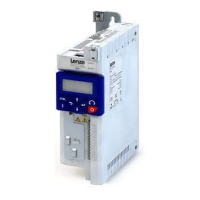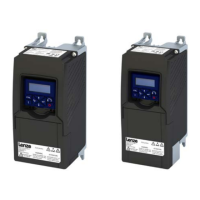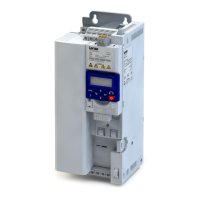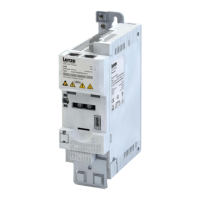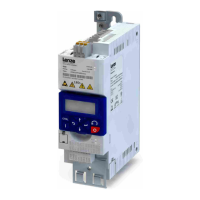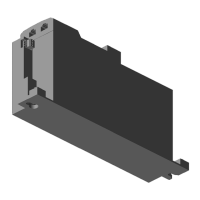Do you have a question about the Lenze I51AE175F and is the answer not in the manual?
General safety measures for handling the product, including warnings and required qualifications for personnel.
Identifies residual hazards associated with the product and motor, including warning labels and hot surfaces.
Details connection plans for 1-phase mains (230/240V) and 3-phase mains (230/240V, 400V, 480V) with fusing and terminal data.
Critical safety warnings regarding incorrect wiring and settings during commissioning, emphasizing checks before power-up and hazardous area clearance.
Explains the need for an operator-process interface for commissioning and details the keypad and EASY Starter software.
Explains that inverters need adaptation to drive tasks via parameter changes, accessible through keypad, EASY Starter, or network controllers.
Details methods for saving parameter settings to the memory module using the keypad or EASY Starter software.
Explains the meaning of the RDY (blue) and ERR (red) LEDs on the inverter front for quick information on operating states.
Lists common diagnostic parameters helpful for operation, maintenance, and error diagnosis, accessible in group 1 of the keypad.
Stores last 32 error/warning messages with text, code, time, and counter. Can be reset via keypad using P155.00.
Provides information on inverter operating status including access protection, parameter settings, control sources, and operating mode.
Explains the i*t utilization function for thermal motor protection, including warning and error thresholds and response selection.
Explains how the inverter detects and responds to errors, categorizing responses into No response, Warning, Trouble, and Fault.
Describes different error types (No response, Warning, Trouble, Fault) and their corresponding behaviors and potential consequences.
Outlines methods for resetting active errors, including keypad, digital inputs, EASY Starter, and network control words.
Describes inverter behavior when memory module data mismatches hardware/firmware, covering automatic loading and manual saving/loading via device commands.
Explains the impact of rated mains voltage on inverter operating range and how to check/set it via parameter 0x2540:001.
Describes how to select the control source (digital inputs, keypad, network) for start, stop, and reversal commands, and displays the active source.
Covers starting and stopping methods, including DC braking, flying restart, automatic start, and various stop methods.
Describes the "quick stop" function as an alternative stop method for faster motor stopping and its associated parameters and triggers.
Details supported motor control modes including sensorless control (SL-PSM, SLVC) and V/f characteristic control (VFC open loop).
Provides step-by-step guidance for basic PID controller settings, including activating PID control, configuring analog inputs, and selecting setpoint sources.
Explains the DC braking function for generating braking torque, its automatic and manual activation, and provides examples.
Addresses DC-bus overvoltage issues during motor braking due to regenerative energy, outlining strategies like stopping deceleration ramp and using inverter motor brake.
Details write access protection options via keypad/EASY Starter, including PIN definition, status display, and impact on functions.
Explains the parameter set change-over function for switching between four sets with different parameter values, with DANGER warnings about immediate effect.
Explains mains failure control for decelerating the motor using rotational energy to maintain DC-bus voltage during power failure.
Lists and explains inverter error codes, their types, configurable parameters, and provides detailed remedies for various errors.
General safety measures for handling the product, including warnings and required qualifications for personnel.
Identifies residual hazards associated with the product and motor, including warning labels and hot surfaces.
Details connection plans for 1-phase mains (230/240V) and 3-phase mains (230/240V, 400V, 480V) with fusing and terminal data.
Critical safety warnings regarding incorrect wiring and settings during commissioning, emphasizing checks before power-up and hazardous area clearance.
Explains the need for an operator-process interface for commissioning and details the keypad and EASY Starter software.
Explains that inverters need adaptation to drive tasks via parameter changes, accessible through keypad, EASY Starter, or network controllers.
Details methods for saving parameter settings to the memory module using the keypad or EASY Starter software.
Explains the meaning of the RDY (blue) and ERR (red) LEDs on the inverter front for quick information on operating states.
Lists common diagnostic parameters helpful for operation, maintenance, and error diagnosis, accessible in group 1 of the keypad.
Stores last 32 error/warning messages with text, code, time, and counter. Can be reset via keypad using P155.00.
Provides information on inverter operating status including access protection, parameter settings, control sources, and operating mode.
Explains the i*t utilization function for thermal motor protection, including warning and error thresholds and response selection.
Explains how the inverter detects and responds to errors, categorizing responses into No response, Warning, Trouble, and Fault.
Describes different error types (No response, Warning, Trouble, Fault) and their corresponding behaviors and potential consequences.
Outlines methods for resetting active errors, including keypad, digital inputs, EASY Starter, and network control words.
Describes inverter behavior when memory module data mismatches hardware/firmware, covering automatic loading and manual saving/loading via device commands.
Explains the impact of rated mains voltage on inverter operating range and how to check/set it via parameter 0x2540:001.
Describes how to select the control source (digital inputs, keypad, network) for start, stop, and reversal commands, and displays the active source.
Covers starting and stopping methods, including DC braking, flying restart, automatic start, and various stop methods.
Describes the "quick stop" function as an alternative stop method for faster motor stopping and its associated parameters and triggers.
Details supported motor control modes including sensorless control (SL-PSM, SLVC) and V/f characteristic control (VFC open loop).
Provides step-by-step guidance for basic PID controller settings, including activating PID control, configuring analog inputs, and selecting setpoint sources.
Explains the DC braking function for generating braking torque, its automatic and manual activation, and provides examples.
Addresses DC-bus overvoltage issues during motor braking due to regenerative energy, outlining strategies like stopping deceleration ramp and using inverter motor brake.
Details write access protection options via keypad/EASY Starter, including PIN definition, status display, and impact on functions.
Explains the parameter set change-over function for switching between four sets with different parameter values, with DANGER warnings about immediate effect.
Explains mains failure control for decelerating the motor using rotational energy to maintain DC-bus voltage during power failure.
Lists and explains inverter error codes, their types, configurable parameters, and provides detailed remedies for various errors.

